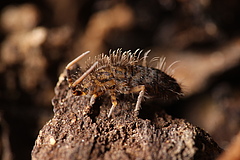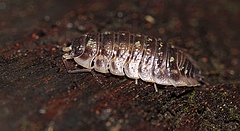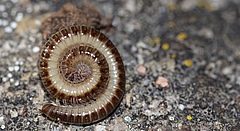How threatened are soil animals?

The predatory soil centipedes can be found worldwide (Photo: Sarah Zieger).

Springtails are so small that they are barely visible to the naked eye (Foto: Sarah Zieger).

This is another species of springtail. The name "springtail" is derived from a tail-like appendage these animals use for jumping (Photo: Sarah Zieger).

Isopods are small crustaeans that live in moist soil (Photo: Sarah Zieger).

The velvet mite has a hairy body (Photo: Sarah Zieger).

Millipeds feed on dead plant material (Photo: Sarah Zieger).
Note for the media: Use of the pictures provided by iDiv is permitted for reports related to this media release only, and under the condition that credit is given to the picture originator.
Soil invertebrates like springtails, millipedes, earthworms, and nematodes are underrepresented in many biodiversity databases. Hence, they are often not considered in analyses about the status and trends of global biodiversity. Specifically, little is known about how below ground biodiversity is threatened by environmental changes such as human land use or climate change. Therefore, the authors of the recently published commentary advocate for large, collaborative initiatives to mobilize the necessary data. “There are two main gaps of knowledge that we need to address”, explains senior author Nico Eisenhauer. “First, we need to determine if global soil biodiversity is currently declining at the local scale, and second, we need to understand which factors drive this potential decline”.
The lack of available data on soil animals is also mirrored by both national and global red lists, where animals dwelling below ground are dramatically underrepresented. Although they appear on some red lists in small numbers, there still is a pronounced bias towards more charismatic organisms such as mammals, fish, butterflies or plants. Red lists are an important tool for biodiversity conservation. Therefore, it is very important to get soil invertebrates represented on those lists, the study authors argue.
Tabea TurriniPublication:Phillips, Helen R. P., Erin K. Cameron, Olga Ferlian, Manfred Türke, Marten Winter & Nico Eisenhauer (2017): Red list of a black box.
Nature Ecology & Evolution 1,
doi:10.1038/s41559-017-0103.Further information:Prof Nico Eisenhauer
Head of the research group Experimental Interaction Ecology at the German Centre for Integrative Biodiversity Research (iDiv) Halle-Jena-Leipzig and Professor at Leipzig University
https://www.idiv.de/groups_and_people/employees/details/eshow/eisenhauer-nico.html





